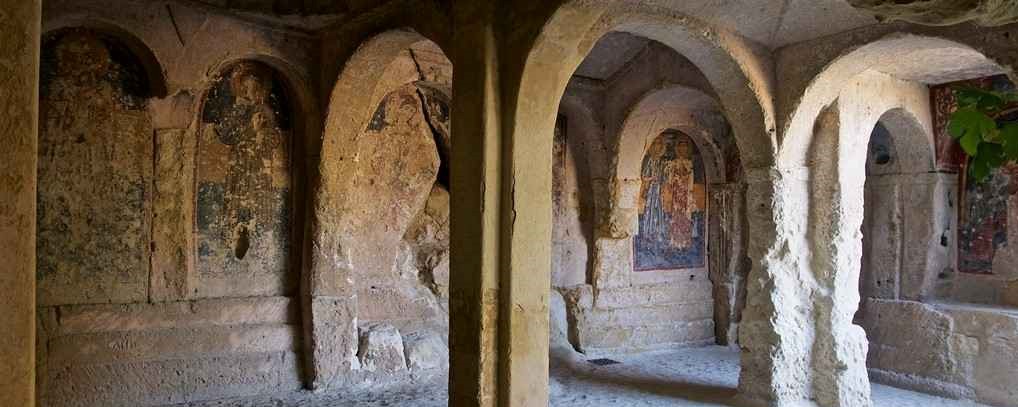

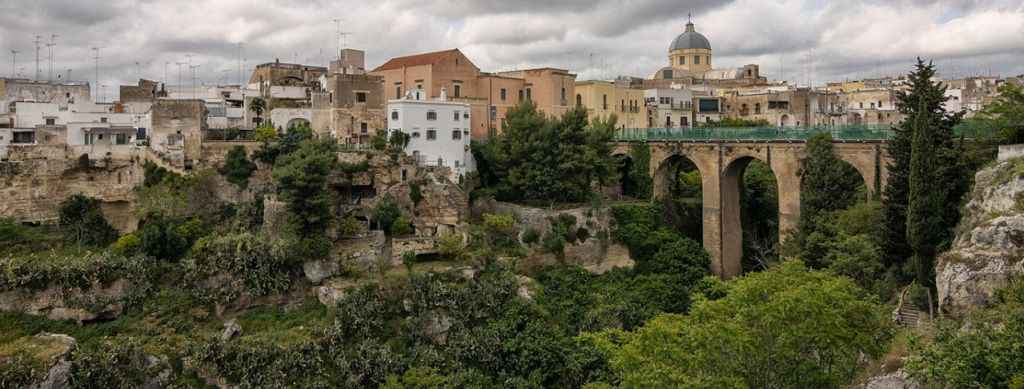


 Suspended between faith and legends, ravines and slightly incised karst valleys, Massafra guards its oldest treasures in the rock. For the vastness and beauty of its cave complexes, Massafra is also called the "Thebaid of Italy". Located in the hinterland north of Taranto, in fact, the city is furrowed by a series of suggestive ravines and valleys of karst origin. The Gravina of San Marco in particular divides the town into two parts connected by bridges and the crossings of them offer enchanting sceneries. Pagan rites and religious cults left their marks over centuries and Massafra shows them in its own territory through one of the largest and most fascinating rock complexes unfolding on the eastern side of San Marco’s Gravina where the rupestrian church of Santa Marina is located , and on the western one where the cave church of Sant'Antonio Abate is set.
Suspended between faith and legends, ravines and slightly incised karst valleys, Massafra guards its oldest treasures in the rock. For the vastness and beauty of its cave complexes, Massafra is also called the "Thebaid of Italy". Located in the hinterland north of Taranto, in fact, the city is furrowed by a series of suggestive ravines and valleys of karst origin. The Gravina of San Marco in particular divides the town into two parts connected by bridges and the crossings of them offer enchanting sceneries. Pagan rites and religious cults left their marks over centuries and Massafra shows them in its own territory through one of the largest and most fascinating rock complexes unfolding on the eastern side of San Marco’s Gravina where the rupestrian church of Santa Marina is located , and on the western one where the cave church of Sant'Antonio Abate is set.
We have to take the provincial road to Martina Franca, instead, to admire the Gravina of the "Madonna della Scala" which owes its name to the sanctuary and includes several housing units as corollary of the vast hypogeum.

The castle of Massafra is located in its historic center, in the locality of Pizzo and overlooks the gravina San Marco. Its structure and architectural motifs are similar to other Apulian castles, with four towers arranged in a quadrilateral linked by ramparts. The oldest towers have circular shape while the south-east one is octagonal

 A scenic monumental staircase climbs the ravine to introduce the fascinating Sanctuary of "Madonna della Scala" in Massafra. There are 125 steps that climb the eastern side of the Gravina di Massafra and give access to the magnificent sanctuary, a fascinating worship place dedicated to the saint patron of the city since 1776.
The history of the sanctuary stems from the legend of the Miracle of the Hinds, according to which, around the fourteenth century, two hinds followed by hunters knelt at the point where a Byzantine fresco of the Virgin was found. In memory of the event, a small chapel was erected in the place of the miracle.
A scenic monumental staircase climbs the ravine to introduce the fascinating Sanctuary of "Madonna della Scala" in Massafra. There are 125 steps that climb the eastern side of the Gravina di Massafra and give access to the magnificent sanctuary, a fascinating worship place dedicated to the saint patron of the city since 1776.
The history of the sanctuary stems from the legend of the Miracle of the Hinds, according to which, around the fourteenth century, two hinds followed by hunters knelt at the point where a Byzantine fresco of the Virgin was found. In memory of the event, a small chapel was erected in the place of the miracle.
Guarded in a limestone block on the eighteenth-century high altar, the fresco is still the heart of the Sanctuary, a sumptuous baroque and neoclassical building, with a Latin cross plan and three naves with ribbed vaults, marked by massive pillars. The bottom of the gravina was known as Valle delle Rose for the spontaneous vegetation and medicinal herbs that grow near the river that runs through it. Close by there is a rock village consisting of over two hundred caves, accessible from the churchyard.
 Along the gravina of the same name, in the territory of Massafra, there is the rock church dedicated to San Marco, carved out of the rock around the fourth century and, later, decorated with inscriptions and semi-columns in the last period of Byzantine domination, in the twelfth century. It is the effigy of the saint, triumphant on the devotional panel of the entrance, to welcome the visitor into the crypt, marked by two naves separated by central pillars and by a presbytery ending with two apses. The structure belongs to the scheme of churches with two twin apses, which the right one is a chair probably reserved for the client. The second apse would have served as a prosthesis for the preparation of the Eucharistic rite and the conservation of liturgical furnishings.Furthermore, from the small window open just above the first apse, the sun's rays illuminate the entire right aisle, creating an evocative atmosphere, an unusual episode in rock architecture.
Along the gravina of the same name, in the territory of Massafra, there is the rock church dedicated to San Marco, carved out of the rock around the fourth century and, later, decorated with inscriptions and semi-columns in the last period of Byzantine domination, in the twelfth century. It is the effigy of the saint, triumphant on the devotional panel of the entrance, to welcome the visitor into the crypt, marked by two naves separated by central pillars and by a presbytery ending with two apses. The structure belongs to the scheme of churches with two twin apses, which the right one is a chair probably reserved for the client. The second apse would have served as a prosthesis for the preparation of the Eucharistic rite and the conservation of liturgical furnishings.Furthermore, from the small window open just above the first apse, the sun's rays illuminate the entire right aisle, creating an evocative atmosphere, an unusual episode in rock architecture.
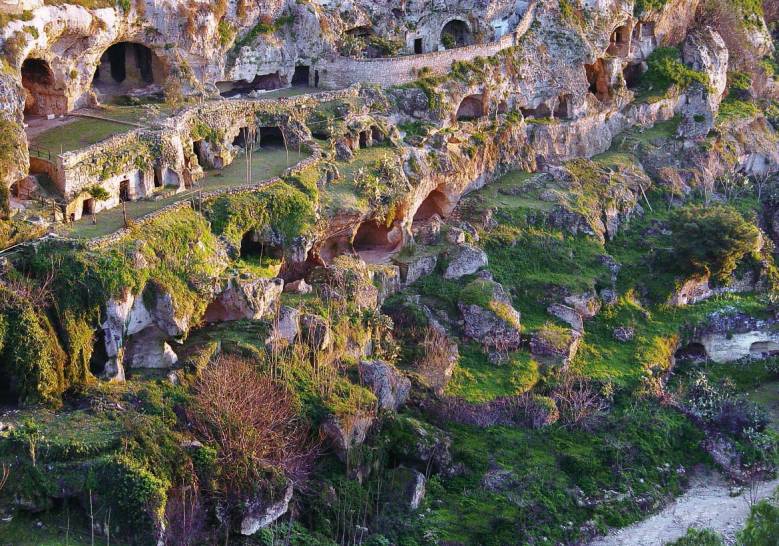
 The Crypt of Santa Marina is considered one of the largest basilica-type churches.Located on the southeastern part of the Gravina di San Marco in Massafra, it is part of a settlement of vast proportions, frequented from the early Middle Ages until the nineteenth century, hypothesis confirmed by presence of a monastery and numerous burials.
The Crypt of Santa Marina is considered one of the largest basilica-type churches.Located on the southeastern part of the Gravina di San Marco in Massafra, it is part of a settlement of vast proportions, frequented from the early Middle Ages until the nineteenth century, hypothesis confirmed by presence of a monastery and numerous burials.
The presbytery ends with three apses with the equivalent number of altars which two dedicated to Latin cult, and one to the Greek cult. The same plan clearly shows oriental influences and the name of the crypt, named after a saint belonging to the Byzantine tradition, only confirms the hypothesis. At one time, the walls were completely covered with frescoes as evidenced by the remains of the representations of Santa Margherita, Santa Marina and Cristo Giudice, dating back to the fourteenth century.
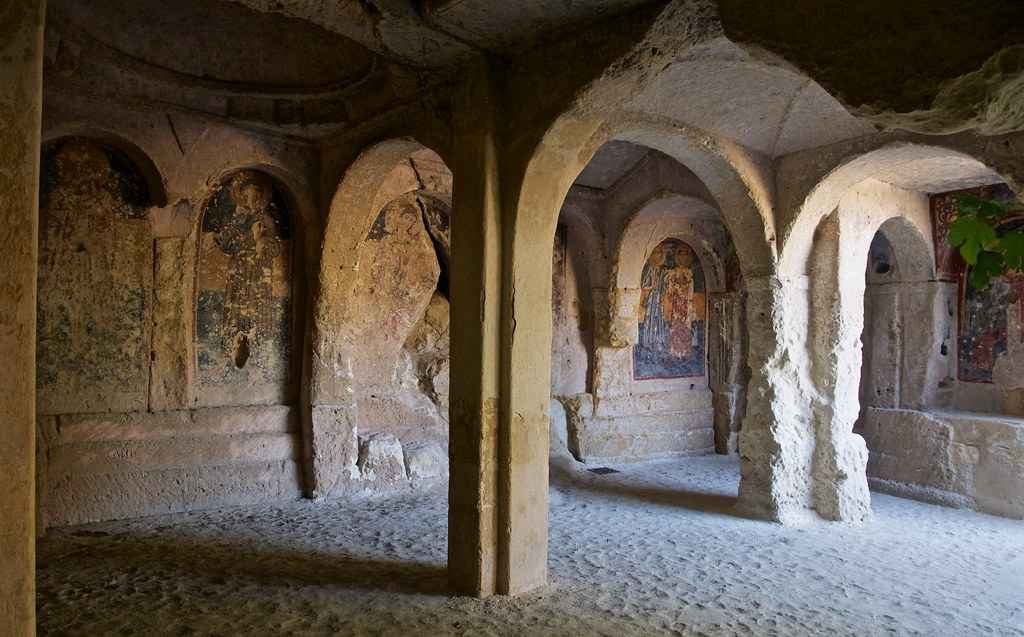 The architecture of this famous rock church - currently altered by the destruction of the facade, which occurred at the end of the 19th century - has an inverse plan, with two pillars that divide the ambient into three naves and six bays, each having a differently decorated vault. The apsidal cap, currently disappeared, with two lateral niches in function of prothesis and diaconicon, was placed in the bema oriented east towards the south nave, to the left of the central entrance. The position of the bema testifies that the liturgical orientation has been respected, and this makes its excavation date to the end of the XII century. The Candelora is famous for its wall paintings that seem to follow the decorative models of the rocky Cappadocia.
The architecture of this famous rock church - currently altered by the destruction of the facade, which occurred at the end of the 19th century - has an inverse plan, with two pillars that divide the ambient into three naves and six bays, each having a differently decorated vault. The apsidal cap, currently disappeared, with two lateral niches in function of prothesis and diaconicon, was placed in the bema oriented east towards the south nave, to the left of the central entrance. The position of the bema testifies that the liturgical orientation has been respected, and this makes its excavation date to the end of the XII century. The Candelora is famous for its wall paintings that seem to follow the decorative models of the rocky Cappadocia.
The paintings are placed in the blind arches and on the eastern wall and the best known among them represents the Presentation in the Temple or Hypapanté, from the Comnena school and dating back to the first half of the thirteenth century, the only Christological scene among the subjects of the wall icons of the temple. Next to it, the presence of a representation of the Virgin who with her hand accompanies the Child holding a basket containing bread or eggs is also of extreme interest, probably a representation of the ancient Byzantine theme of the Christ Trophy or of spiritual nourishment (XIII- XIV century);
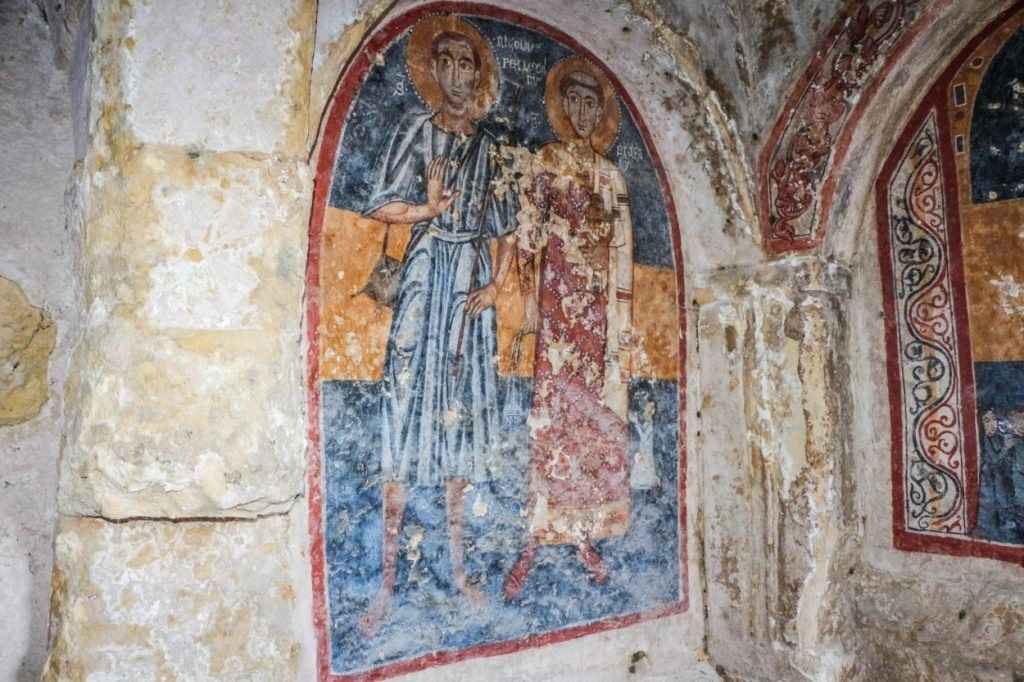 at his feet two figurines of patrons, probably husband and wife. In the northern wall the arches house, from right to left, the diptych of St. Nicholas the pilgrim and St. Stephen, also having at his feet a figure of a client in white priestly dress, and a Madonna with Child, placed between two images of St. Nicholas. All these sacred paintings can be dated between the end of the XIII and the beginning of the XIV century, as well as on the western wall the icons of San Giovanni Evangelista, San Pietro, Sant'Antonio Abate, San Marco - also has a figure of client with censer - and a Virgin and Child enthroned or Platitera.
at his feet two figurines of patrons, probably husband and wife. In the northern wall the arches house, from right to left, the diptych of St. Nicholas the pilgrim and St. Stephen, also having at his feet a figure of a client in white priestly dress, and a Madonna with Child, placed between two images of St. Nicholas. All these sacred paintings can be dated between the end of the XIII and the beginning of the XIV century, as well as on the western wall the icons of San Giovanni Evangelista, San Pietro, Sant'Antonio Abate, San Marco - also has a figure of client with censer - and a Virgin and Child enthroned or Platitera.
 The large underground complex actually consists of two adjacent rock churches, located in the basement of the former Pagliari hospital. The current reservoir is due to their fusion, through the demolition of the rock diaphragm that separated them. Both churches are binavate, with the apses facing east. The oldest of the crypts, whose excavation could date back to the X-XI century, is the one located further south, and has the raised quadrangular bema with semi-circular apse, most likely, originally, accompanied by a wooden iconostasis and which it seems attributable to the Greek rite. The Latin rite was officiated in the other church, which shows, in the flat-bottomed apse, an 18th-century baroque altar, topped with a fresco by Sant'Antonio Abate, dated to the same period. The frescoes by Blessed Pope Urban V date back to the 14th-15th centuries, holding a tablet with the faces of Saints Peter and Paul, the Annunciation, located to the left of the entrance, another fresco of Saint Anthony, and that of San Giacomo, dressed as a pilgrim.
The large underground complex actually consists of two adjacent rock churches, located in the basement of the former Pagliari hospital. The current reservoir is due to their fusion, through the demolition of the rock diaphragm that separated them. Both churches are binavate, with the apses facing east. The oldest of the crypts, whose excavation could date back to the X-XI century, is the one located further south, and has the raised quadrangular bema with semi-circular apse, most likely, originally, accompanied by a wooden iconostasis and which it seems attributable to the Greek rite. The Latin rite was officiated in the other church, which shows, in the flat-bottomed apse, an 18th-century baroque altar, topped with a fresco by Sant'Antonio Abate, dated to the same period. The frescoes by Blessed Pope Urban V date back to the 14th-15th centuries, holding a tablet with the faces of Saints Peter and Paul, the Annunciation, located to the left of the entrance, another fresco of Saint Anthony, and that of San Giacomo, dressed as a pilgrim.
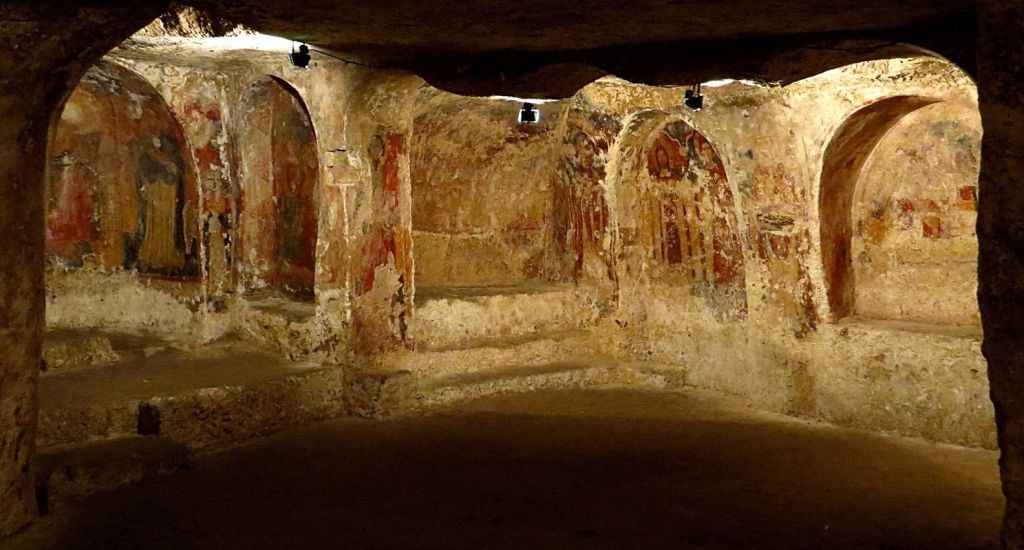 In the oldest crypt, on the sides of the entrance door, San Nicola and Santa Caterina (XII-XIII century) are painted on the left. The representation of Sant’Eligio stands on the southern wall, flanked by a diptych with Santa Elena and San Leonardo and, therefore, a large fresco of San Nicola and a Virgin with Child. Next to the bema there is a large niche where the Crucifixion with the Trinity is depicted. Before the bema, St. James the Apostle is still frescoed, while in the presbytery, from right to left, we find images of an Annunciation, of St. Peter Martyr, of the Pantocrator in déesis, of another painting by Sant'Antonio Abate and, therefore, of a San Vito, a Crucifixion and a Santo Stefano. The bema frescoes have been dated to the 14th-15th centuries.
In the oldest crypt, on the sides of the entrance door, San Nicola and Santa Caterina (XII-XIII century) are painted on the left. The representation of Sant’Eligio stands on the southern wall, flanked by a diptych with Santa Elena and San Leonardo and, therefore, a large fresco of San Nicola and a Virgin with Child. Next to the bema there is a large niche where the Crucifixion with the Trinity is depicted. Before the bema, St. James the Apostle is still frescoed, while in the presbytery, from right to left, we find images of an Annunciation, of St. Peter Martyr, of the Pantocrator in déesis, of another painting by Sant'Antonio Abate and, therefore, of a San Vito, a Crucifixion and a Santo Stefano. The bema frescoes have been dated to the 14th-15th centuries.

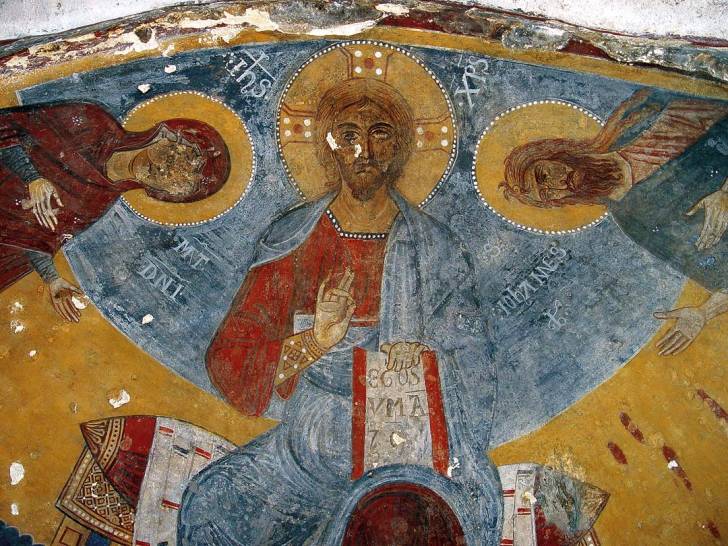 The hypogean church probably originates from a classical chamber tomb, readapted to a sacred place in the early Middle Ages. It is accessed through a downhill corridor or dromos and currently has a large rectangular hall with a single quadrangular pillar.
The hypogean church probably originates from a classical chamber tomb, readapted to a sacred place in the early Middle Ages. It is accessed through a downhill corridor or dromos and currently has a large rectangular hall with a single quadrangular pillar.
The vault is flat and partially collapsed; to the east there is a semi-iconostasis and therefore the bema, slightly raised, which has the semicircular apse, and the only diaconicon on its left. In fact, the excavation, to the right of the apse, of the Prothesis - the other constant element of the Byzantine architecture of the Bema - seems to have been interrupted due to static instability in the rock bank.
The endowment of the sacred frescoes of the rock church is remarkable: starting from the left, on the iconostatic septum we find the remains of the portraits of the apostles Saint Andrew and Saint Peter, then a holy deacon, probably Saint Stephen;
 on the first pillar, a Saint Nicholas, flanked by the Archangel Gabriel on the semi-collapsed wall of access to the apse, and the Virgin Annunciation on the opposite septum, flanked by the pillar, where traces of a halo remain faint. In the arch between the two pillars are paintings of Santi Medici San Cosma (right) and San Damiano (left), of Comnene influence, dating back to the thirteenth century. Even the San Paolo Eremita and Sant’Antonio Abate, frescoed in the arch between the classroom and the diaconicon, belong to the conservative Byzantine art of this period.
on the first pillar, a Saint Nicholas, flanked by the Archangel Gabriel on the semi-collapsed wall of access to the apse, and the Virgin Annunciation on the opposite septum, flanked by the pillar, where traces of a halo remain faint. In the arch between the two pillars are paintings of Santi Medici San Cosma (right) and San Damiano (left), of Comnene influence, dating back to the thirteenth century. Even the San Paolo Eremita and Sant’Antonio Abate, frescoed in the arch between the classroom and the diaconicon, belong to the conservative Byzantine art of this period.
In the apse there is a beautiful representation of the Byzantine school of the Pantocrator in déesis dating back to the fourteenth century. Traces of other frescoes can be found on the pillar of the classroom and on the west wall of the crypt, the latter most likely depicting an Annunciation.
